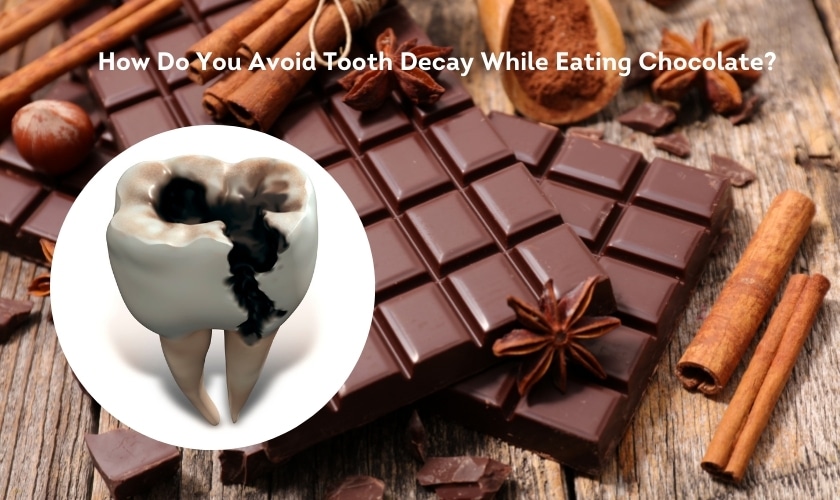Chocolate. The very word conjures images of creamy indulgence and delightful satisfaction. But for those of us who care about our dental health, that sweet treat can also trigger anxieties about cavities and tooth decay. Can you really avoid tooth decay while eating chocolate? The answer is yes! By understanding the science behind chocolate and oral health, and following some smart practices, you can continue to enjoy your favorite treat without compromising your smile.
This blog delves into the fascinating world of chocolate and its impact on your teeth. We’ll explore the role of sugar in tooth decay, how different types of chocolate affect your oral health, and, most importantly, equip you with practical tips on how to avoid tooth decay while eating chocolate. So, grab a square (or two!), settle in, and get ready to learn how to satisfy your cravings without sacrificing your pearly whites.
The Role of Sugar in Tooth Decay
Before we dive into chocolate’s impact, let’s understand the primary culprit behind cavities: sugar. The bacteria naturally present in your mouth feed on sugar, producing acids as a byproduct. These acids erode tooth enamel, the hard outer layer protecting your teeth. Over time, this erosion can lead to cavities.
According to the American Dental Association, tooth decay is the most common chronic childhood disease in the United States, affecting nearly half of all children aged 6 to 8 years old. While sugary drinks often take the blame, sugary treats like chocolate can also contribute to the problem.
How Chocolate Affects Tooth Health?
Not all chocolate is created equal when it comes to its impact on your teeth. Here’s a breakdown of how different types of chocolate affect your oral health:
- Dark Chocolate: The good news! Dark chocolate, with a higher cocoa content (70% or more), generally contains less sugar than milk chocolate or white chocolate. Additionally, some studies suggest that the cocoa flavanols in dark chocolate might have properties that help reduce the stickiness of bacteria to teeth. So, dark chocolate offers a potentially lower risk of cavities compared to lighter varieties.
- Milk Chocolate: This popular type of chocolate contains a higher proportion of milk solids and sugar compared to dark chocolate. While still delicious, the increased sugar content translates to a greater risk of tooth decay.
- White Chocolate: Technically not “real” chocolate as it doesn’t contain cocoa solids, white chocolate is primarily made from sugar, cocoa butter, and milk. This high sugar content makes it the least tooth-friendly option among the three.
So, the darker the chocolate, the better when it comes to avoiding tooth decay while eating chocolate.
Tips for Eating Chocolate Without Causing Tooth Decay
Now that you understand the science behind chocolate and tooth decay, let’s explore some practical tips to help you enjoy your favorite treat guilt-free:
1. Choose Dark Chocolate: As mentioned earlier, opt for dark chocolate with a high cocoa content (70% or more) to minimize sugar intake and potentially benefit from the presence of flavanols.
2. Mind Your Portion Size: Enjoy chocolate in moderation. Savor a small piece or two instead of indulging in a whole bar. This reduces the amount of sugar your mouth is exposed to at once.
3. Pair it with a Meal: Eating chocolate with a meal can help neutralize the effects of sugar. Food stimulates saliva production, which helps wash away sugar particles and neutralize acidity in your mouth.
4. Rinse Your Mouth Afterward: After enjoying chocolate, consider rinsing your mouth with water. This simple act helps remove any lingering sugar particles and reduces the acidic environment in your mouth.
5. Brush and Floss Regularly: Maintaining a consistent oral hygiene routine is crucial to avoiding tooth decay while eating chocolate. Brush your teeth twice daily with fluoride toothpaste and floss at least once a day to remove plaque and bacteria buildup.
6. Schedule Regular Dental Checkups: Regular dental checkups allow your dentist to identify and address any potential dental issues early on.
Conclusion
Chocolate cravings are a natural part of life, and with a little knowledge and these helpful tips, you can continue to enjoy this delicious treat without jeopardizing your oral health. Remember, avoiding tooth decay while eating chocolate is all about balance and smart practices. Choose dark chocolate, control your portion sizes, maintain good oral hygiene, and schedule regular dental visits with Dentist Sugar Land. With these steps in place, you can have your chocolate and a healthy smile too!
